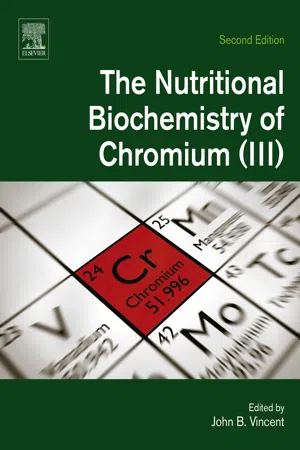
The Nutritional Biochemistry of Chromium(III)
John Vincent
- 396 pages
- English
- ePUB (mobile friendly)
- Available on iOS & Android
The Nutritional Biochemistry of Chromium(III)
John Vincent
About This Book
The Nutritional Biochemistry of Chromium(III), Second Edition, reviews the fields of chromium biochemistry and nutrition and how they have dramatically changed in the last decade. Editor John Vincent has lead much of the research that has resulted in new discoveries and reversals of previously held beliefs, such as health concerns surrounding the toxicity of chromium(III). New sections include a review of new evidence showing why chromium may not be an essential element, why national recommendations may need updating, and new data on the use of chromium supplementation in animal feeds.
Discussions on the controversial topic of the role of chromium(III) at the molecular level in insulin signaling and information on cell cultures and in vitro assays of chromium toxicity are also covered.
- Examines all of the significant research surrounding chromium, providing discussion on both sides of controversial issues
- Features new evidence that shows why chromium may not be an essential element
- Details why national recommendations may need updating
- Edited by leading expert in the field of chromium, with new contributions from leaders in different aspects of chromium research
Frequently asked questions
Information
Introduction: A history of chromium studies (1955–2007)
Abstract
Keywords
Acknowledgments
Introduction
Chromium(III)
The Glucose Tolerance Factor (GTF) Story
The identification of GTF
Table of contents
- Cover image
- Title page
- Table of Contents
- Copyright
- Contributors
- Preface to revised edition
- Chapter 1: Introduction: A history of chromium studies (1955–2007)
- Part I: Chromium as a Nutrient and Nutritional Supplement
- Part II: Biochemical Role(s) for Chromium(III)
- Part III: Chromium(III) as Therapeutic Agent
- Part IV: Toxicological Effects of Chromium(III)
- Index